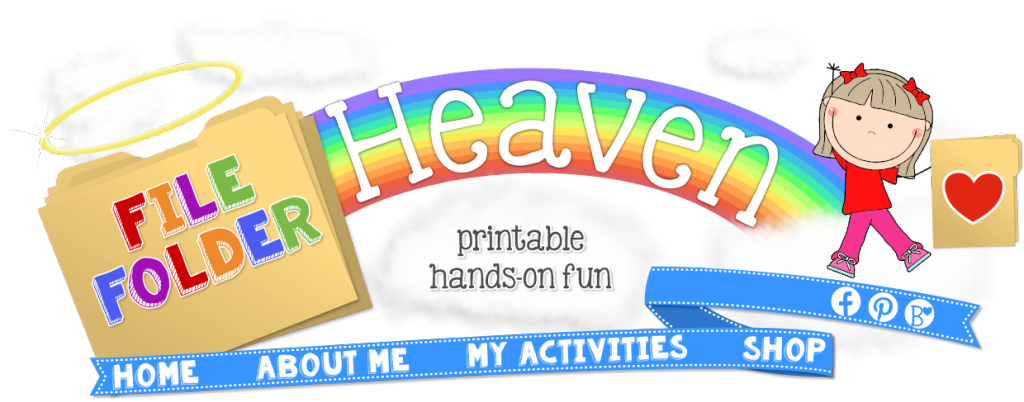A while back, I received an email from a teacher that wanted to use adapted books in her classroom, but she didn't have access to binding combs or a binding machine. I guess I assumed that most teachers had access to binding machines at their schools. But apparently many do not. So if you fall into that category and are looking for an alternate method to assemble your books, here is the "tried and true," "3 ring binder" method. For this assembly method, I am going to use my new,
"Where's The Student' Standing?" Adapted Book, that focuses on locations in the school. So let's get started!
To assemble your adapted book, you will need a 1 inch, three ring binder, plastic sheet covers, and velcro dots.
 |
| 3 Ring Binder, Plastic Sheet Covers, Velcro Dots and File Folder |
In this assembly method, you will not need to laminate the pages of your book, because they will be protected by the plastic sheet covers. You will only need laminate any matching or interactive pieces that the book may have.
So, the first step is to slip the title page, into the outer plastic cover of the binder and put your plastic sheet covers inside the binder.
 |
| Title Page Inside Plastic on Outer Cover of 3 Ring Binder |
Next you'll put the story inside of the plastic sheet covers. I always put two pages per sheet cover. This way the story will flow from front to back. I find using the plastic sheet covers so much faster than laminating and cutting the pages out. But the plastic sheet covers aren't cheap! ;(
 |
| Story on Both Sides of Plastic Sheets, Velcro Dots On Top of Plastic Sheets |
Then you will want to add your Velcro dots. I LOVE Velcro dots. Can I just say that these are the best invention in perhaps, EVER? I hand-cut Velcro for several years, often leaving my hands achy and my scissors all gunky. I can't tell you how many pairs of scissors I ruined--and I know so many of you know exactly what I am talking about. But, never again, my Friends! Velcro dots are pre-cut, and just about the perfect size for most activities. And I have to admit--my inner "Type A Teacher" is so satisfied by their perfectly round, perfectly symmetrical appearance on my books. ;)
So next you will place a 1 soft-sided Velcro dot on top of the plastic sheet cover, inside each blank square where, the students will be matching their pieces. (Please see above picture)
After that, you will create a choice board for your matching pieces. I love using a file folder for this, because it provides nice visual organization for students and it makes storing the pieces so neat and easy. In this particular book, there are matching pieces, in addition to pieces for an object/association exercise that comes after the book.
I attach my my matching pieces to the book on the outside of the file folder using Velcro dots. Make sure to attach rough-sided Velcro to the back of each piece so that they will match up to the soft sided Velcro you have already put in your book.
 |
Matching pieces to book
|
On the inside of the file folder, I attach the matching pieces that go to the object/association activity. This keeps the pieces separate as you are working with students, and provides that visual organization that many students need.
 |
| Matching Pieces to Object/Association Activity |
As you read through the book with students, they only use the pieces on the front cover of the file folder.
 |
| Story and Matching Pieces |
When you finish the book, and begin to work through the object/association matching activity, you open up the file folder to reveal the pieces the matching pieces that go with that activity. This set up works for any adapted book that has an additional activity at the end of it.
 |
| Matching Pieces That Go With Object/Association Activity |
When you are completely finished with the book and matching activity, you just slip the file folder (with matching pieces attached) inside the sleeve of the 3 ring binder cover. This makes storage so simple and your book is ready to go for the next time you use it.
 |
| File Folder And Pieces Stored in Inner Sleeve |
So, my question for you is-- Which assembly method do you use? Binding combs or binders and why? Or are you using something totally different and unique? I'd love to know! ;)
A Quick Footnote: I threw this question out to
File Folder Heaven Facebook Page after I had published this post. From the feedback, I received, I learned than many teachers still prefer the traditional binding comb method. Some are using the binder method. Several use a standard hole punch with three small metal rings. One teacher uses a hole punch with tied ribbon and one teacher reported using a hole punch with zip ties. (Now those are a couple of methods that I'm going to have to try!)
My husband always swears that a zip tie will fix anything.... ;)

























